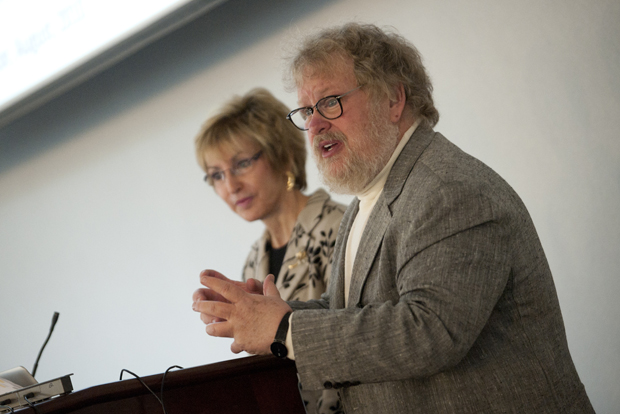Classroom technology requires academic reboot

In a student’s capable hands, a smartphone might as well be a rocket ship.
“It’s got a camera, a GPS and an accelerometer,” said University of Michigan electrical engineering and computer science professor Elliot Soloway. He was addressing teachers, academics and industry professionals who filled the Raytheon Amphitheater on Monday for a daylong conference on using technology in the classroom. “These are far more powerful than your average computer.”
Soloway and Cathleen Norris, a professor in the College of Education at the University of North Texas, delivered the keynote address for Northeastern’s sixth annual Teaching with Technology Day, which was sponsored by the university’s Educational Technology Center and Academic Technology Services.
Provost Stephen Director, who invited Soloway and Norris to speak on campus, welcomed attendees to the conference.
“I thought it would be useful to discuss what the students of today, and, more importantly, the students of the future, know about technology,” he said.
The lively keynote address focused on the way college students use technology. Soloway and Norris said colleges will have to continue to shape their curriculums to meet the demands of increasingly connected students.
Smartphones, Soloway explained, are “far more powerful tools than your average computer.” He noted that handheld mobile devices engage students in far more dynamic ways than a netbook, laptop or tablet computer, which often stay in a student’s backpack.
Students often use mobile phones to take photos or record audio on their way home and then bring their findings back to the classroom for further discussion and learning, he said.
The ubiquity of mobile technology, noted Norris, makes it easy for users to rapidly access reliable information about nearly any topic. This can serve as an opportunity for educators to shift their focus to broader, more complex discussions, she said.
“It’s the big picture questions — the how and the why — that technology is going to let us focus on,” Norris said. “You can get the who, what and where in a second, so you don’t have to spend as much time on them.”
The daylong conference also included talks on new hardware and software for use in education and sessions on programs and products available from companies such as Adobe, Apple, Pearson and Blackboard.





